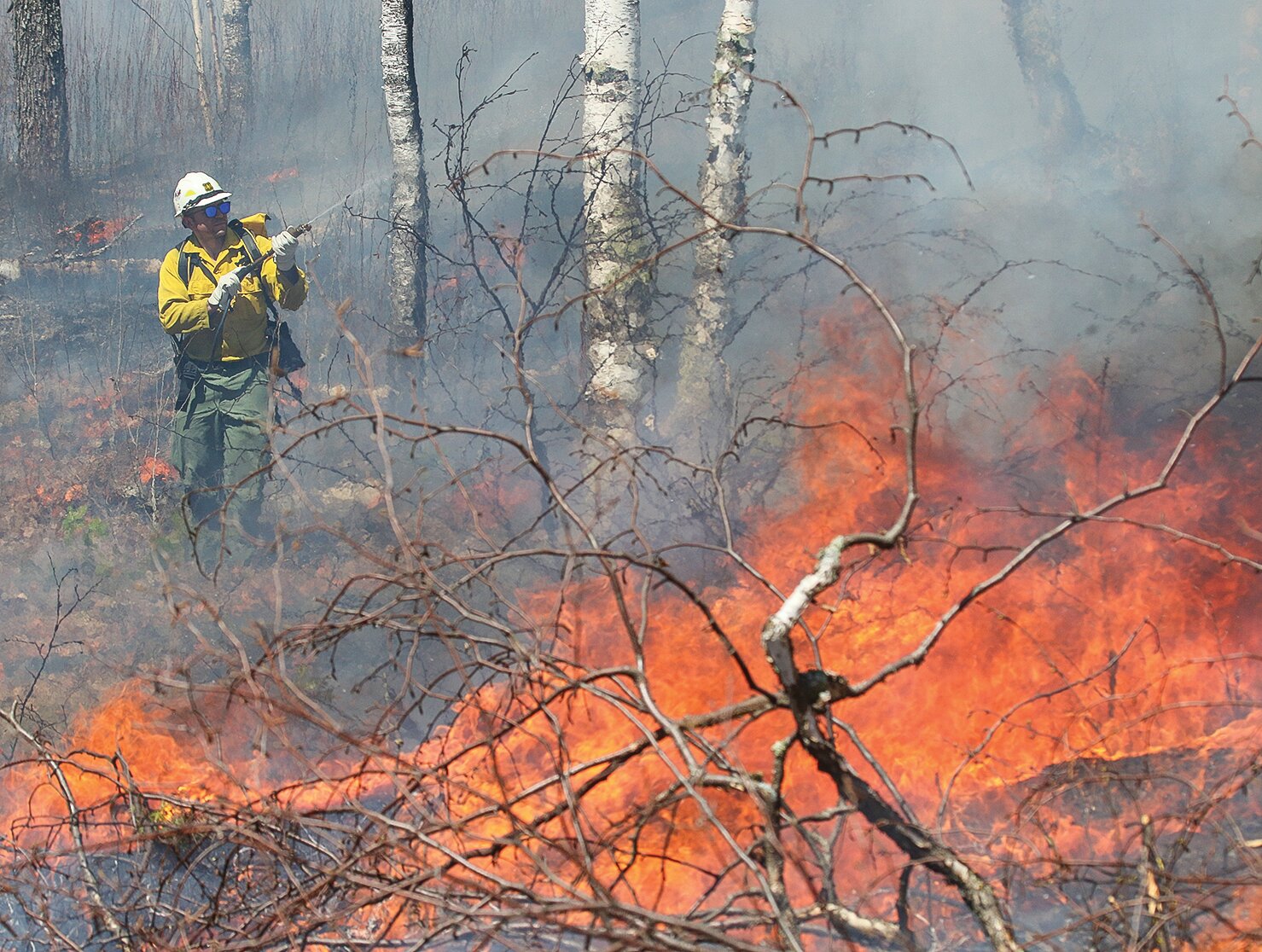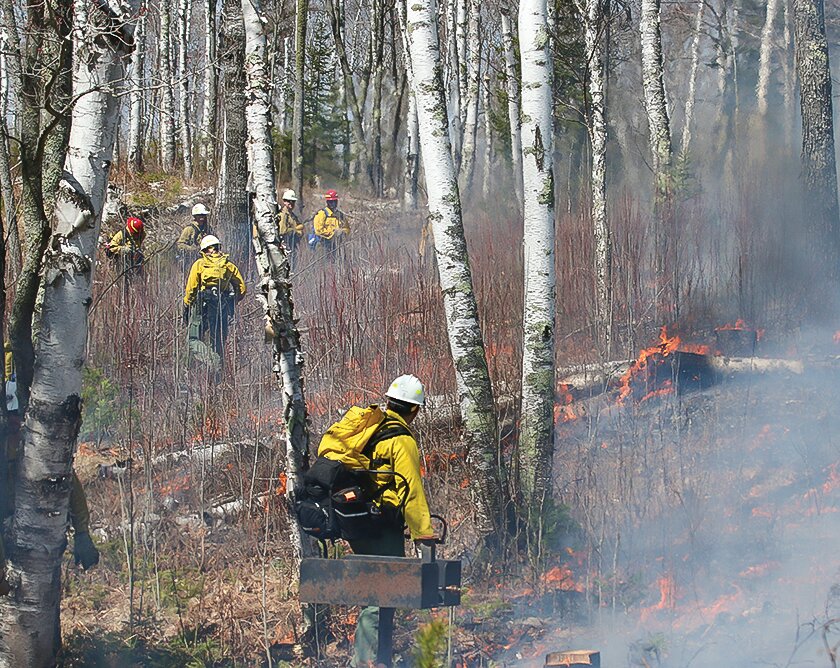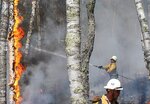Support the Timberjay by making a donation.
Fighting fire with fire
Forest Service working to reduce fire danger through prescribed burning
SUPERIOR NATIONAL FOREST— The wind was picking up by midday but that just made the fire “snappier” in the terminology of the fire officials here who were taking advantage of a dry …
This item is available in full to subscribers.
Attention subscribers
To continue reading, you will need to either log in to your subscriber account, below, or purchase a new subscription.
Please log in to continue |
Fighting fire with fire
Forest Service working to reduce fire danger through prescribed burning
SUPERIOR NATIONAL FOREST— The wind was picking up by midday but that just made the fire “snappier” in the terminology of the fire officials here who were taking advantage of a dry window in the weather late last week to undertake one of dozens of prescribed fires planned across the forest this spring.
Last week’s burn was along the northwest shore of Pfeiffer Lake, a popular campground, beach, and picnic area maintained by the forest service on the Superior’s Laurentian District. This particular burn encompasses three different blocks, totaling about 32 acres, making it one of the smaller burns planned on the Superior this spring. The largest planned fire is nearly 1,900 acres, dubbed the Kawishiwi Lakes fire, located on the Tofte District.
The U.S. Forest Service, with help from the Nature Conservancy, hopes to complete just over 7,000 acres of burning in an effort to restore the use of fire in forest management in the region.
“The boreal forest is fire dependent,” notes Tim Engrav, who works in the Superior’s LaCroix office and serves as public information officer during fire season. According to Engrav, the suppression of fire beginning a century ago in the U.S. upset that longstanding natural process and laid the groundwork for far more catastrophic wildfires.
“It’s about using a lower intensity fire under the right conditions versus a wildfire that’s most likely to occur when the conditions are the worst,” he said.
Wildfire, which is often driven by high winds when conditions are exceptionally dry, not only endangers public safety but can cause far greater damage to the forest, destroying far more trees, burning up dry soils, and killing significant amounts of wildlife. It can also threaten homes and cabins, as was the case with the Greenwood fire in 2021.
Prescribed fires are undertaken when conditions are expected to be less explosive and they’re designed to function primarily as an “underburn,” that reduces or kills brush and consumes dangerous forest fuels, like dead and dried balsam fir, without reaching the crowns of larger trees where the fire can quickly spread.
In the case of the Pfeiffer Lake burn, Engrav said a primary objective was to reduce the amount of balsam fir seeds in the leaf litter. Balsam fir is a particularly significant fire threat because it is abundant and grows well in the understory of larger trees, like pine, aspen, and birch. When alive, fir trees can quickly catch fire because of the volatile oils in their needles and bark. Because of their dense branches and needles, whole trees can ignite or “candle” in a matter of seconds and send flames shooting skyward, where they can ignite the crowns of taller trees. That tendency is the reason balsam fir is considered the most dangerous “ladder fuel” in the North Country.
The danger posed by balsam fir has been even greater in recent years, due to a combination of spruce budworm and regular drought, which has killed millions of fir trees in the region, leaving many standing dead or fallen but suspended off the ground, where they can quickly dry and fuel catastrophic fires.
Engrav said the forest service has tried to suppress the growth of balsam fir around developed sites, such as Pfeiffer Lake, but that mechanical treatments they have used in the past have not been as effective as they would like. By using fire, officials are hopeful they can eliminate the seed source for balsam fir in and around the campground, which should prove a longer-lasting solution.
Planning for fire
While fire can be an effective forest management tool here in the North Country, it can also be a dangerous one. Engrav said that’s why the forest service establishes “prescriptions” for each fire, which sets parameters, such as fuel moisture levels, relative humidity, and expected winds, in which they believe they can safely control the fire.
It’s a careful balancing act since conditions also need to support sufficient fire activity to meet the forest management objective. When conditions get outside the parameters established for each burn, fire officials can quickly shut it down.
It has generally worked well on the Superior in recent years, although the Foss Lake fire west of Ely back in 2016 was an example of a prescribed burn that got away when conditions changed suddenly, although it resulted in no significant damage.
There were no such surprises during last week’s burn, even as a strong south wind was up close to the limit set in the prescription. The fire burned easily in the dry conditions and stuck mostly to the ground, although it did occasionally flare up the side of a paper birch tree with plenty of loose, flaky bark.
The firefighters quickly completed a three-acre burn near the campground’s beach and picnic area, then spent the afternoon on a 15-acre burn just north and west of the campground. Despite the gusty wind, which occasionally swirled in the hilly terrain along the bigger burn, the roughly 30 people on the burn crew had little difficulty keeping the fire within the prescribed boundaries. The third burn block, about 14 acres in size, is scheduled for next fall, said Engrav.
Indeed, much of the forest service’s ambitious burn plan will likely wait for fall as recent rains have made effective burning impossible. “It hasn’t shut the door on some units,” said Engrav. He noted that some wildlife openings tend to be grassy and fine fuels can dry quickly and support a hot fire with just a couple days without rain. “We’ll definitely be watching for drier weather,” said Engrav.













